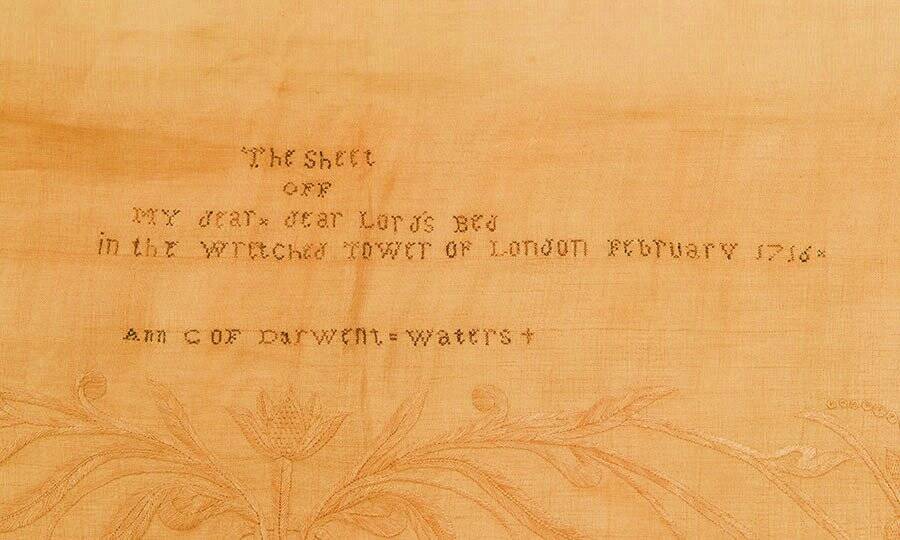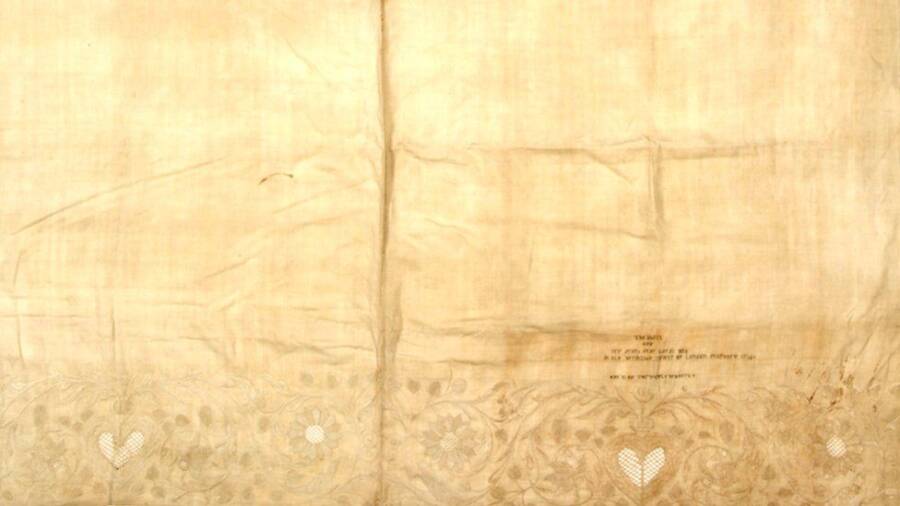Anna Maria Radclyffe likely embroidered the message with the hair of her husband, James Radclyffe, who was executed in 1716 for rebelling against the King of England.

Museum of LondonThe note reads: “The sheet OFF MY dear dear Lord’s Bed in the wretched Tower of London February 1716 x Ann C of Darwent=Waters”
After her husband was executed in 1716, Anna Maria Radclyffe sat down to do some embroidery. But she used unusual tools. For cloth, she used the bedsheet from his Tower of London prison cell. And for thread, she used human hair — possibly plucked from his severed head.
“This embroidered bedsheet is an extraordinary item, which would have taken months or years to create,” explained Beverley Cook, curator of social history at the Museum of London.
“The care and devotion speaks to Anna’s personal devastation and remarkable character — determined to protect the memory of her husband long after his death.”
Anna Maria’s husband, James Radclyffe, the third Earl of Derwentwater, was executed on Feb. 24, 1716, for his involvement in the Jacobite rebellion of 1715. James and other rebels had tried — and failed — to put the son of a deposed Catholic king back on the throne.
James was sent to the Tower of London to await his beheading. Though Anna Maria often joined him there, James also sent her love letters in which he called her his “dearest worldly treasure” and urged her to be courageous and not melancholy.

Public DomainJames and Anna Maria Radclyffe were married in 1712 and had two children.
“It would be lovely to think that they were lying together beneath this sheet,” said Cook, noting that the sheet didn’t look too worn and may have only been used during his four-month stay in the Tower.
“Obviously, we can’t prove that, but it’s likely that she conceived their daughter at that time.”
Following James’ execution at the age of 26, his heart was sent to an Augustinian convent. Anna Maria was given his body — with his head sewn back on.
“That would have given her the opportunity of removing some of his hair,” said Cook, noting that Anna Maria kept some of her husband’s hair in a locket. “And we do know that, obviously, taking locks of hair was quite a common thing for people to do.”
Cook also speculated that Anna Maria used both James’ hair and her own, since the hair sewn into the bedsheet looks like two distinct colors. Other decorations on the sheet include flowers, leaves, and a wreath in the shape of a heart. Unlike the love message, these additions are stitched with linen thread.
Anna Maria later fled the country with her children, settling in Brussels in the hopes of raising them Catholic. Sadly, she died in 1723 from smallpox.
But the bedsheet that Anna Maria had embroidered with human hair lived on. Generations of James’ supporters and other activists guarded it over the centuries until the Museum of London obtained it in 1934.

Museum of LondonThe hair-sewn inscription is only a small part of the bedsheet, which is also decorated with flowers and a heart motif.
In the end, the execution of rebels like James Radclyffe staunched, but did not stop, the push by Jacobites to restore a Catholic to the throne.
Though they failed in 1715 to place the “Old Pretender” James Stuart, son of the deposed Catholic King James II and VII of England and Scotland on the throne, his son Charles Edward Stuart led the next Jacobite rebellion in 1745. However, Stuart also suffered a bloody defeat.
Indeed, the bedsheet represents one part of England’s violent history. It will be part of an “Executions” exhibit at the Museum of London Docklands in October 2022. The exhibit will also display other items from 700 years of executions in England, such as clothing worn by King Charles I at his beheading in 1649, a gallows recreation, and letters written by the condemned.
“Public executions became embedded in the landscape and culture of London, influencing people’s everyday lives,” explained Meriel Jeater, another curator at the Museum of London.
“Hints of this uncomfortable past can still be seen in the city’s streets today and Executions will allow visitors to explore this grim but fascinating aspect of London’s history through a major exhibition for the first time.”
Though Anna Maria’s bedsheet is “a sort of relic to Catholic martyrdom,” as Cook puts it, it also represents a wife’s dedication to her husband — even beyond the grave.
After reading about the love note sewn with human hair, go inside the botched execution of Mary, Queen of Scots. Or, look through 33 of the world’s most disturbing museum artifacts.





